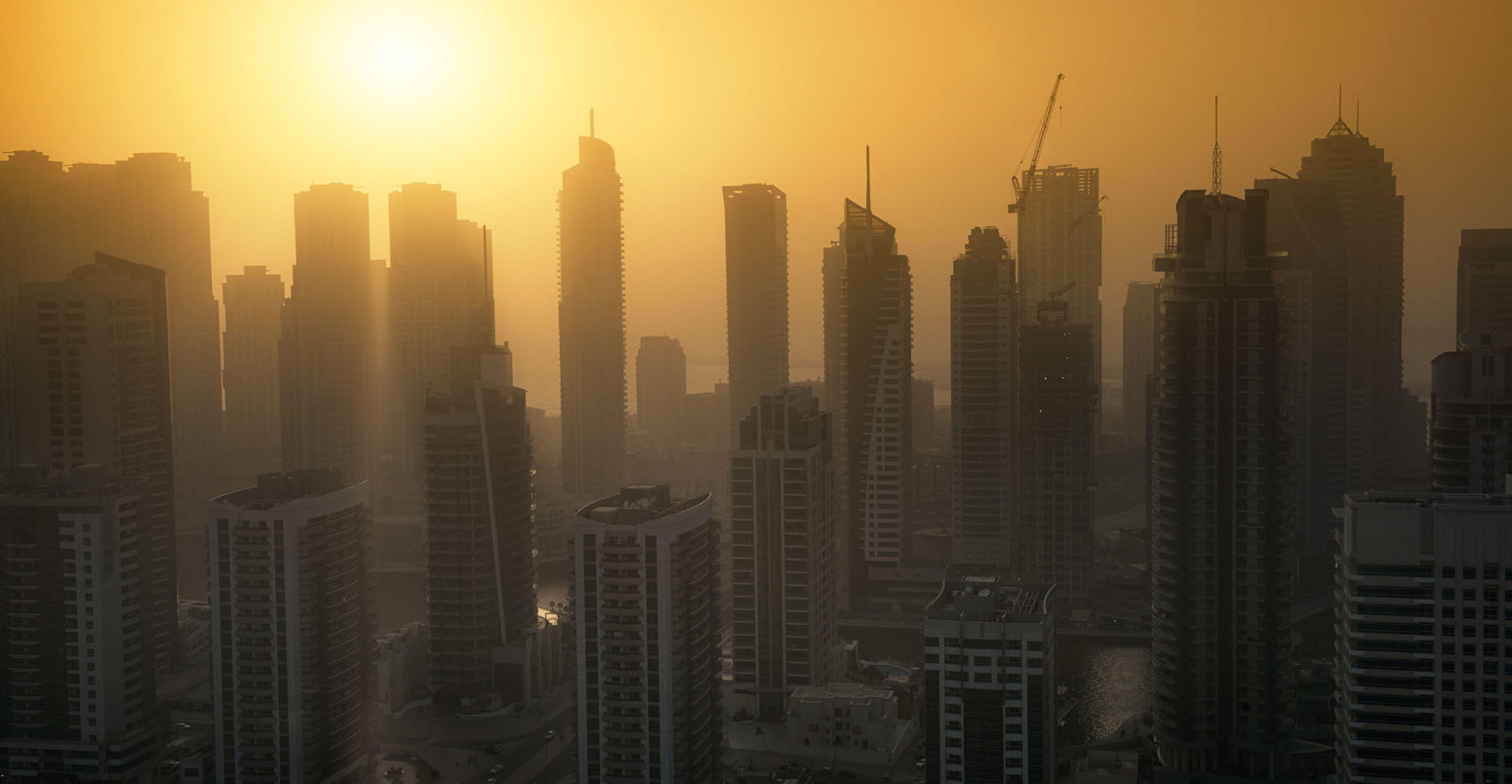
Analysis: When might the world exceed 1.5C and 2C of global warming?
Zeke Hausfather
12.04.20Zeke Hausfather
04.12.2020 | 6:06pmUnder theParis Agreementadopted in 2015, virtually all the world’s nations pledged to limit global warming to “well below” 2C above pre-industrial levels and also, if possible, “pursue” efforts to cap warming at 1.5C. At present, the world isnot closeto being on track to meet either target.
While the growth of global emissionshas slowedin recent years, there is alarge and growing gapbetween current commitments and what would be needed to avoid exceeding these global temperature limits.
Here, Carbon Brief provides an analysis of when the world is expected to pass these limits in the absence of large future emissions reductions. This is based on the latest generation of climate models – known as ”CMIP6” (see Carbon Brief’sexplainer) – that are being run in the lead up to theIntergovernmental Panel on Climate Change’s (IPCC)sixth assessment reportexpected in 2021-22.
Our analysis shows that:
- The world will likely exceed 1.5C between 2026 and 2042 in scenarios where emissions are not rapidly reduced, with acentral estimateof between 2030 and 2032.
- The 2C threshold will likely be exceeded between 2034 and 2052 in the highest emissions scenario, with a median year of 2043.
- In a scenario of modest mitigation – where emissions remain close to current levels – the 2C threshold would be exceeded between 2038 and 2072, with a median of 2052.
Understanding the Paris Agreement limits
Determining when the world has exceeded a temperature limit, such as 1.5C or 2C, is far from a simple matter.
For example, there is some disagreement among experts around the reference “baseline” period. While theParis Agreementdescribed the temperature limits as “above pre-industrial levels”,no clear periodis defined as pre-industrial. Observational temperature records only extend back to 1850 for some groups producing surface temperature records, and 1880 for others.
Climateproxydata and longer records for some specific locationscan be usedto estimate earlier temperatures – which areup to 0.2C coolerthan the late 1800s – and some scientistshave arguedthat this earlier period is the more appropriate baseline. However, most researchers and international climate negotiators have continued to use the mid-to-late 1800s as the basis for the pre-industrial baseline period.
There are also notable differences between observationalsurface temperature recordsregarding how much global warming has occurred, both in the 1800s and in recent years. For example, theBerkeley Earthrecord shows that the world has already warmed by 1.25C since the pre-industrial (1850-1899) period, while theMet Office/UEA HadCRUT4record only shows 1.06C warming over the same period.
Similarly, over the past 50 years theNASA GISTEMPrecord shows closer to 0.1C more warming than the HadCRUT4 record. These differencesare primarily dueto methodological choices and the data used, but can make a large impact when assessing whether a particular temperature limit has been passed, particularly for 1.5C where the remaining allowable warming is small.
Finally, there is the question ofhow to determineat what point a temperature limit has been exceeded.
全球平均地表温度在任何给定的year are driven by a combination of long-term warming and short-term natural variability. The latter – driven byEl Niño and La Niña events, orvolcanic eruptions– can result in a year being up to 0.2C warmer or cooler than the trajectory of long-termhuman-caused warming. This means it is quite possible for humans to have only warmed the world by 1.3C – only slightly above where we are today – and see a single year that exceeds 1.5C. In fact, theWorld Meteorological Organizationrecently estimatedthat there is one-in-four chance that the world will exceed 1.5C for at least one year by 2025.
The international community of researchers and policymakers is more concerned with the effects of long-term human-caused warming than short-term natural variability. Because of this, passing the 1.5C and 2C limits has generally been defined based on a multi-year average rather than a single year, though there is no clear agreed-upon approach.
In this analysis, Carbon Brief provides a straightforward approach for removing short-term natural variability from both historical and future modelled temperatures, and calculates when the world would expect to exceed the 1.5C and 2C targets based onthe latest resultsfrom the new CMIP6climate models.
The figure below shows an example of the approach taken to separate the long-term warming trajectory from the year-to-year variability in a single climate model run. A smoothed average is produced using a local regression (LOWESS) approach that uses a 25-year period. This differs from a simplemoving average, however, as it gives nearby years more weight in the resulting smoothed average than those further away.
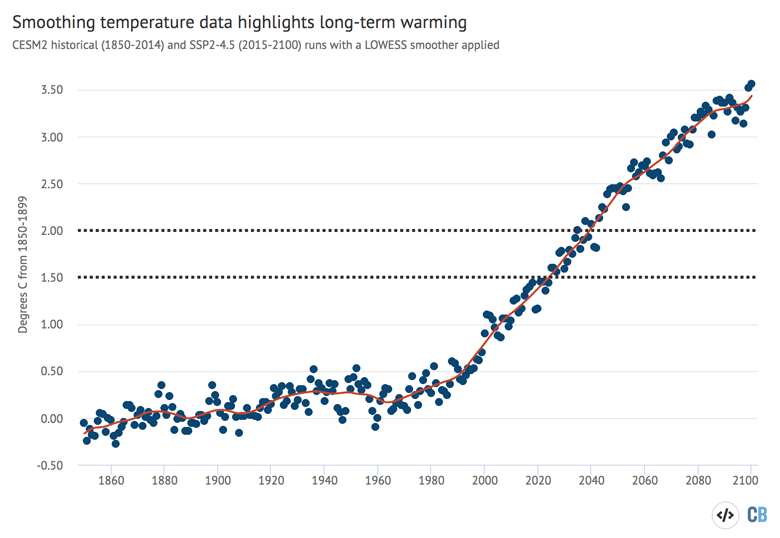
The smoothed model data – from the US National Center for Atmospheric Research’s CESM2 model – shown in red in the figure above passes 1.5C just four years from today in 2024.
However, CESM2 has 1.4C of warming relative to pre-industrial in 2020, compared to only 1.2C observed in the real world. This means that the year it crosses 1.5C is more due to historical mismatches between the model “hindcast” and observational temperatures than the speed of expected future warming.
Simply using the warming since the pre-industrial period in each model to determine when 1.5C and 2C targets will be exceeded would be quite misleading, as some models either overestimate or underestimate the actual amount of warming that the world has experienced.
Therefore, rather than looking at models starting in the 1800s, we can look at observed temperatures through to the present day and how much additional future warming is projected by different climate models.
The figure below shows an example of this approach. It uses a smoothed average of observational temperature records up to 2020 and all of the different CMIP6 climate models running a particular scenario (SSP2-4.5; see below) after that point. Each climate model shows the warming from the year 2020.
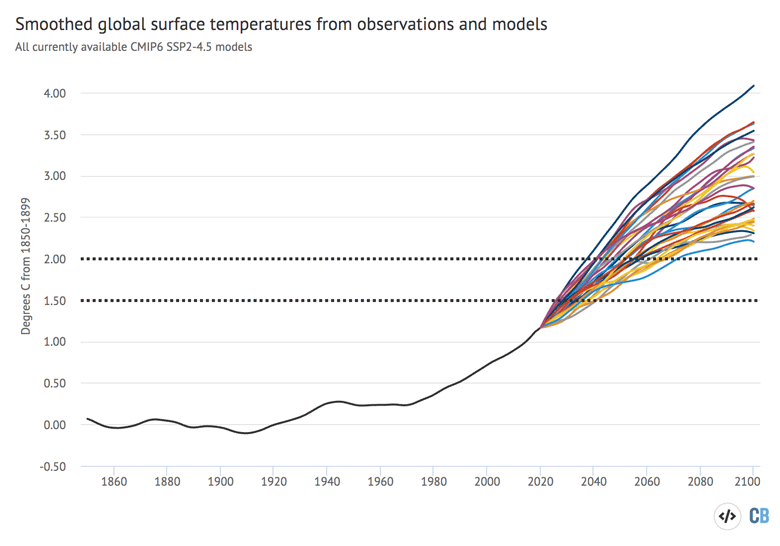
When will global warming reach 1.5C?
To estimate when global temperatures are likely to exceed the 1.5C and 2C limits, both historical observations and the latest CMIP6 climate models are used – and then smoothed to remove year-to-year natural variability.
CMIP6 models are run for a wide range of future emission scenarios in different “Shared Socioeconomic Pathways” (SSPs; see Carbon Brief’sexplainer). Under more stringent mitigation scenarios, such as SSP1-1.9 and SSP2-2.6, global warming may never exceed 1.5C or 2C in some CMIP6 model runs.
Under SSP1-1.9 – which was designed to have a good chance at avoiding 1.5C of global warming by 2100 – two of the 12 model runs currently available never exceed 1.5C at any point during the 21st century. Many of the runs that do exceed 1.5C only “overshoot” temporarily and then have temperatures decline back to below 1.5C by the end of the 21st century. However, four of the 12 models remain firmly above 1.5C in 2100.
Because SSP1-1.9 has some models that never exceed the targets, our analysis focuses on the other four scenarios that currently have a large number of CMIP6 runs available – SSP1-2.6, SSP2-4.5, SSP3-7.0, and SSP5-8.5. In all four of these scenarios – which involve moderate to no future emissions mitigation – global average surface temperatures exceed 1.5C in all CMIP6 models.
The figure below shows when global temperatures might be expected to exceed the 1.5C target across all the different CMIP6 models. The bars represent the full range of “exceedance” dates for a particular SSP scenario, while the black dots represent all the individual model estimates.
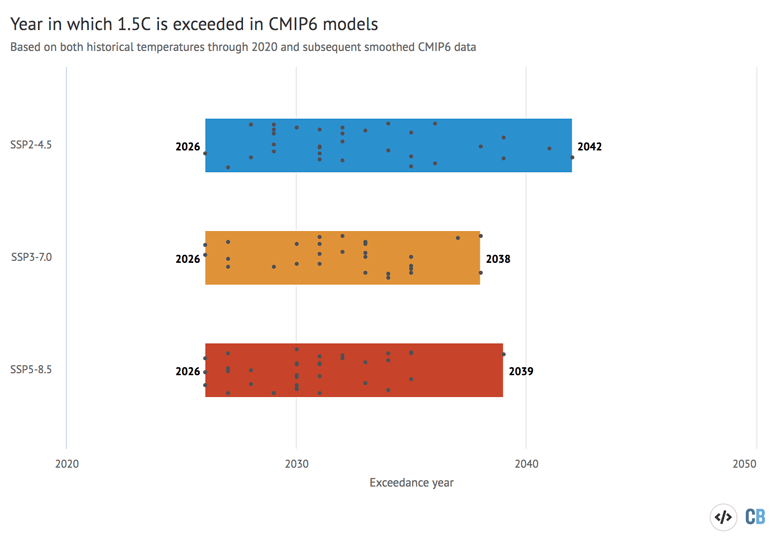
Global surface temperatures are expected to exceed 1.5C between 2026 and 2057 in the SSP1-2.6 scenario, with amedian estimate2033股。的年代SP2-4.5, it is between 2026 and 2042 in the scenario, with a median of 2032.
的年代SP3-7.0, it is between 2026 and 2038 with a median of 2032, while the SSP5-8.5 scenario has temperatures passing 1.5C between 2026 and 2039 with a median of 2030.
It is worth noting that the latestIEA World Energy Outlookprojections suggest that the world is likely to follow a trajectory close to SSP2-4.5 over the next two decades, with emissions remaining relatively flat.
The other scenario for which a notable numbers of model runs are available – SSP1-1.9 – shows median estimates of 2031 (between 2029 and 2052), though this range excludes the 3 of 12 available model runs that never exceed the target temperature.
These results are quite similar to those in the last generation of models – CMIP5, which underpinned the IPCC’sfifth assessment reportpublished in 2013-14 – using the same approach. In theRCP8.5 scenario, CMIP5 models pass 1.5C between 2027 and 2036, with a median estimate of 2031.
A different approach to estimating the exceedance year is to simply take the rate of historical warming over the past 30 years and extend it into the future. In that case, we would expect global temperatures to exceed 1.5C around 2037, which is within the range expected in a SSP2-4.5 scenario of relatively flat emissions, but a bit higher than its median year of 2032.
When will global warming reach 2C?
The figure below shows a similar analysis for the 2C target. Here the exceedance year varies a lot more across SSP scenarios, as the larger distance between the target and current observed warming allows more time for differences between scenarios to impact the results.
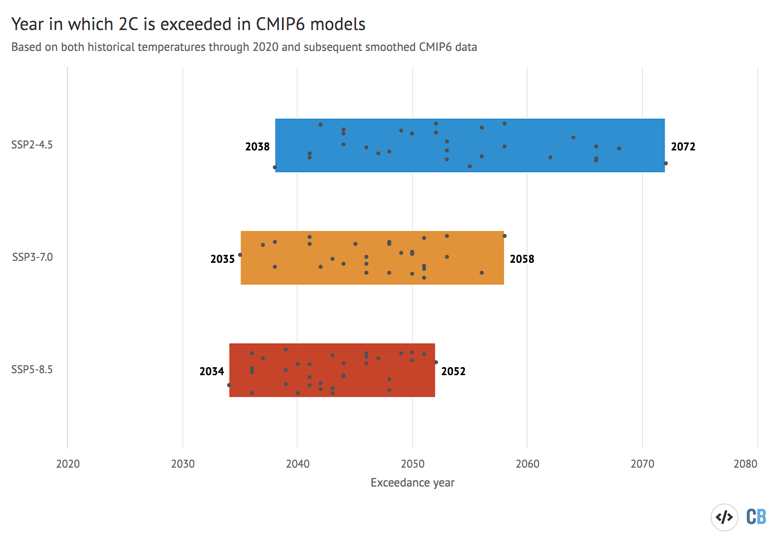
Temperatures are expected to pass 2C in the modest-mitigation SSP2-4.5 scenario – where emissions remain around current levels – between 2038 and 2072, with a median year of 2052.
In the higher emissions SSP3-7.0 scenario, 2C is passed between 2035 and 2058 with a median year of 2048. And, in the worst-case SSP5-8.5 scenario, it is passed between 2034 and 2052 with a median of 2043.
These results are also reasonably in-line with those of the last generation of models – CMIP5 – whose exceedance dates were between 2038 and 2053 with a median of 2045 in the RCP8.5 scenario.
If the historical warming trend over the past 30 years is extended into the future, global temperatures would be expected to exceed 2C around 2062 – which is similarly within the range of the SSP2-4.5 scenario, but a bit higher than the median year.
Some of these differences between historical and modeled warming may reflect the fact that models are reporting global surface air temperatures, while our observational record is mixing (slightly slower warming) sea surface temperatures over land with surface air temperatures over the ocean.
What is the remaining carbon budget?
The year in which models exceed the 1.5C and 2C temperature targets can also be used to calculate the remaining globalcarbon budget, based on the CO2 emissions in each of the different SSP scenarios.
For the 1.5C target, this gives an estimated remaining carbon budget – from 2020 – of 749bn tonnes of CO2 (GtCO2), with a range of 489GtCO2 to 1,189GtCO2 across all the models.
这有点高于remaining carbon budgetfor a 50% chance of limiting warming to 1.5C in the recentIPCC Special Report on 1.5C(SR15) of around 500GtCO2 (based onblended land/ocean temperatures).
However, caution is warranted when comparing carbon budgets implied by climate models to those in the SR15.Piers Forster教授at theUniversity of Leedstells Carbon Brief:
“The scenarios have different non-CO2 warming, as the non-CO2 warming in the SR15 report carbon budget estimates were from a scenario that peaked at 1.5C or 2C, so you need to consider how this is different in the SSPs than in the SR15 scenarios…That’s why I’m not a big fan of always doing things with respect to the remaining carbon budget. Note that the budget also gets exhausted a few years before 1.5C as there is around a two-year lag between emissions and warming.”
If the world does not begin to rapidly reduce emissions, it is clear that the 1.5C target will be passed sometime between 2026 and 2042.
Climate models show a wide range of possible exceedance dates, due to different estimates ofhow sensitivethe climate is to CO2, as well asinternal variabilitywithin the models.
Similarly, if future emissions remain roughly flat, the world will exceed 2C warming above pre-industrial levels between the 2040s and 2070s. Whereas, if emissions continue to increase, global warming could exceed 2C between the 2030s and 2050s.
-
Analysis: When might the world exceed 1.5C and 2C of global warming?
-
Analysis: When could the 1.5C and 2C Paris Agreement limits be breached?

